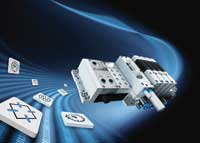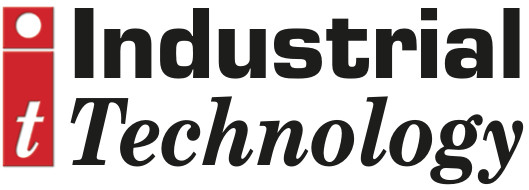
Posted to News on 29th Oct 2018, 00:00
Pneumatics in the 21st Century and beyond
If the future is digital, what role is there for pneumatics in the world of 21st century Automation? Andy Parker-Bates of Festo investigates how the technology is adapting to change.

Turn the pages of any industrial trade magazine today and you will find numerous articles relating to the digitalisation of the factory and how Industry 4.0 is going to change the face of manufacturing immeasurably. They explain how plants of tomorrow will seamlessly connect horizontally along their supply chains and vertically through their own processes and systems. Customers will be able to go online, configure their own unique product, press a button and raise an order directly on the factory. Autonomous systems will then order raw materials, schedule the build, allocate resources and start the production line running.
For most SMEs in the UK this may seem a long way off their current production environment: but there are already technological shifts taking place in the automation industry that will ultimately transform this vision of future manufacturing into a reality.
Cloud connectivity, the industrial internet of things, data analytics and edge computing are adding impetus to the next digital revolution and there is no doubt that it will create a fundamental shift in the way plant and equipment will be designed, built, operated and maintained. In what is clearly a digital – and therefore electrically driven – future, where does that leave pneumatics? Does a technology that claims to trace its routes back to first century Greece and which found mass popularity in the 1960s, 70s, and 80s have a future in the context of 21st century automation?
According to the British Fluid Power Association (BFPA), rather than declining, sales of pneumatics have actually been growing over the last few years; demonstrating that the technology has lost none of its favour with UK manufacturing.
It may come as a surprise to some, but innovators within the pneumatics industry are already at the heart of the Industry 4.0 revolution and embracing it as an opportunity to drive pneumatic technology forward into a whole new generation of products and solutions to meet the challenges of future manufacturing.
One of the biggest criticisms levelled at pneumatics over the years has been the cost of compressed air and overall lifecycle cost. Pneumatics manufacturers have for several years been addressing this issue by promoting a more efficient use of compressed air through best engineering practices and efficient product design.
One such example is the Festo MSE6-E2M energy efficiency module, which can detect when a machine is idling or in standby and automatically shut off the flow of compressed air to the machine. As well as performing this energy saving function, the unit also provides leak monitoring and captures live flow, pressure, and consumption data. This data can be sent across an industrial network connection or up into the cloud, allowing users to undertake long-term energy usage analytics and control. In fact, improved connectivity and data capture provides evidence that the economics of pneumatics are relatively stable and makes total cost of ownership easy to predict, which is very attractive to machine builders and end-users alike.
OEE (overall equipment effectiveness), although around since the 1960s, is the key concept underpinning much of the development across the pneumatics industry. Industry 4.0 will provide new understanding of machines and processes: allowing them to be autonomously configured and optimised, and so driving up machine availability, performance and quality.
Pneumatics has already proven itself in terms of its rugged nature and ability to withstand and adapt to the rigours of its working environment, be that ATEX, washdown, cleanroom, mobile, or submerged. Added to this, improved material properties, new production techniques and high-volume manufacturing are driving down the cost of core pneumatic components such as cylinders and valves while driving up quality and reliability. This makes pneumatics a natural choice for high-volume, repetitive, fit and forget applications. No other technology is as at home in such diverse conditions.
The ability to predict when a particular machine component will fail has been a goal of industry for many years. Much time and money has been (and continues to be) spent on monitoring and trying to understand which characteristics are a predicter of failure – and then, more importantly, how long it takes for the component to fail.
Valve terminals with embedded intelligence that monitor the number of switching operations, power supply condition and hours run are already commonplace. Pressure, flow and position sensors are now being equipped with IO-Link, delivering hot-swap capabilities and advanced diagnostics.
The real benefits of condition monitoring are derived when it is extended down to actuator level. The Germany ParsiFAl 4.0 research project is exploring how to make this possible. It brings together a number of leading technology partners from industry and academia to develop new sensor technology and electronics in thin foils.
The project aims to attach a label like an adhesive strip to a Festo pneumatic cylinder to gather sensor and user data which is then sent wirelessly and securely to a corresponding control system. In this way, drive data such as position, dynamics and environmental parameters can be monitored simultaneously by several labels in a unit. An energy harvesting system, which generates energy from the movement of the piston, is expected to supply the foil system with power in conjunction with a thin film battery.
By analysing component level data and production environment characteristics and modelling this against the manufacturer’s own test data, predictions can be made about the expected life of a particular device under its actual real-life operating conditions. Control elements can subsequently be optimised by self-learning systems to either provide less arduous operating dynamics, or to maintain maximum productivity until the current production run is completed.
With the promised rise in mass customisation and ever smaller batch sizes, electric drive technology is extremely well placed as its infinitely variable nature adapts to whatever the manufacturing process demands of it. Capable of being re-configured ‘on the fly’ as different product sizes, weights, or even types pass along the line, electric drives certainly appear to have an advantage over static, dedicated pneumatic systems. But who said pneumatic systems must be static?
Festo’s motion terminal is the pinnacle of pneumatic development today. Using piezo-electric controlled valves tied to software-driven motion apps, the motion terminal is able to change the functions of its valves in much the same way an electric drive can. Each valve can effectively replicate the functionality of up to 50 separate pneumatic components, allowing operating pressures to be changed digitally to suit a particular product type, with cylinder travel times and stroke lengths adjusted for different product formats.
Once again, a connection to the plant’s fieldbus network ensures that control and diagnostic reporting happen seamlessly and in real time.
In conclusion, digitalisation of the factory and the declining cost of electric motive power will inevitably lead to a gradual migration away from pneumatics to these more controllable, connected technologies. However, developments are already taking place in the industry to create more efficient, cost-effective, intelligent and connected products.
So, rather than being side-lined by Industry 4.0, pneumatics is a technology that fits hand in glove with its contemporaries and is key to delivering the transformation that will drive future manufacturing.







